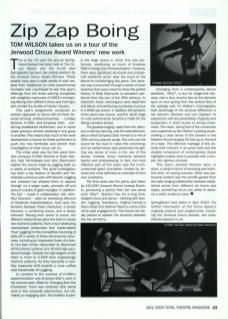This is the 7th year the annual Springboard festival has been held at The Circus Space and the fourth year Springboard has been the central platform for the Jerwood Circus Award Winners. These awards have seen a wide variety of work created from traditional to more experimental concepts and I journeyed to see this year's offerings from the three winning companies with delightful memories of 2003's enchanting offering from Gifford's circus and their bijou tent amidst the bustle of Hoxton Square.
This year's programme contained an eclectic approach to circus with all three Jerwood-winning artists/companies – Lindsey Butcher, K-DNK, and Empress Stah – containing established performers, and in some cases previous winners assisting in one guise or another. This meant that much of the work represented a chance for these performers to push into new territories and stretch their investigation of what circus can be.
The initial week saw the first piece from new company K-DNK (formed of Sean Gandini, Kati Ylä-Hokkala and John Blanchard) explore the sound made by juggling balls on a variety of surfaces. This aural investigation has been a key feature of Gandini and Ylä-Hokkala's previous work with Gandini Juggling and Jerwood has allowed them to explore 'boings' on a larger scale, primarily off and around a series of giant triangles. In addition, No Exit – made in collaboration with John-Paul Zaccarini – sees an increasing element of theatrical characterisation, built upon the tensions between three characters: a dowdy introvert, a lumbering tramp, and a sleazy extrovert. Moving from scene to scene, the different relationships allow the balls to create new rhythmic patterns; from a soul-destroying mechanised 'production line’ (table-based ‘thud' juggling) to the competitive bouncing of balls off a variety of three-dimensional structures, including an impressive finale of a frantic four-ball combo rebounded by Blanchard off the interior surfaces of a ten-foot high equilateral triangle. Despite the high degree of skill there is more to K-DNK than engrossingly rhythmic patterns, for they exemplify a carefully measured shift towards a more unified total theatricality for juggling.
In contrast to the success of K-DNK's experimentation was Empress Stah's work in the second week. Billed as Swinging from the Chandelier there was relatively little aerial work in this outwardly adventurous, but ultimately un-engaging solo. The problem is partly the large space in which this was performed, swallowing up much of Empress Stah's energy and characterisation. However, there were significant structural and conceptual problems which bear the brunt of the blame for hamstringing this piece. The narrative was constructed through a series of short sketches that were meant to show the potted history of Dolly Diamante (a decadent performer from the turn of the 20th Century). In execution these monologues were disjointed and bland, only achieving momentary humour in a WWII spy scene. In addition the dynamic of the piece was uneven, and the 'adult' edge of nude performance became a mask for the failing narrative thread.
The greatest tragedy, apart from the ridiculous nude tap dancing, was the extended periods in which Empress Stah mimed to a mix of 20th Century popular songs. Not only was the sound far too loud to make this convincing, but her performance style prevented me getting any sense of irony in the use of this device. Instead, these moments became painful and embarrassing. In fact, the most effective part of this piece was the much-underused giant chandelier, funded by Jerwood and most definitely an example of form over substance.
The final week saw the prime spot taken by £10,000 Jerwood Winner Lindsey Butcher, previewing a section from her new aerial work Why?. Butcher has, for a long time, bridged circus and dance – working with Gandini Juggling, Scarabeus, Virginia Farman's Disco Sister and Siobhan Davis to name a few of her past engagements. This leaves her ideally placed to explore the tensions between the two art forms.
Emerging from a contemporary dance aesthetic, Why?, a duo for single-line harness, had a taut, punchy feel as the dancers spun on and sprang from the vertical face of the upstage wall. Fin Walker's choreography took advantage of the physical difference in her dancers (Butcher and Lee Clayden) to experiment with the possibilities of gravity and suspension in short bursts of arcing movement. The clean, slicing feel of the movement was supported by Ben Maher's pulsing score, evoking a clear sense of the tension in the freedom found hanging twenty-foot up on the end of a rope. This effective marriage of the visceral thrill inherent in all aerial work and the studied composure of contemporary dance highlights exactly what is possible with a simple, but rigorous concept.
This year's Jerwood Winners were, in short, a varied mixture of arresting and inventive work, of varying success. What was particularly evident was the benefit gained from the wide-ranging collaboration between established artists from different artforms and styles, something circus can utilise to develop a wider audience base.
Springboard took place in April 2004. For further information on the Circus Space's ongoing projects and programmes, including the Jerwood Circus Awards, see www. thecircusspace.co.uk

